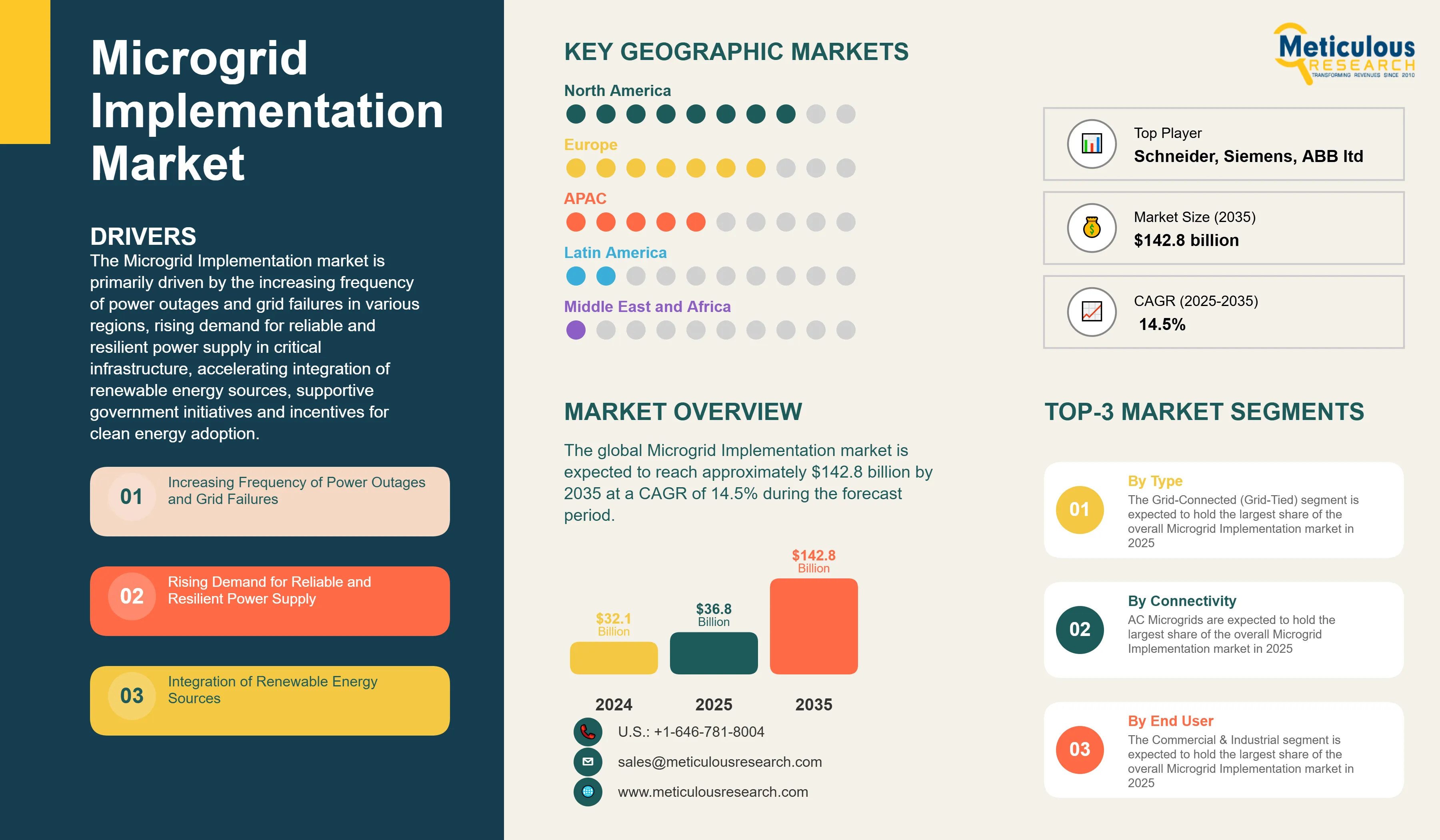Resources
About Us
Microgrid Implementation Market: Size & Forecast by Grid Type (Grid-Connected, Off-Grid, Hybrid), Power Source (Solar PV, Wind Turbines, Fuel Cells, CHP, Diesel, Natural Gas), Connectivity (AC, DC, Hybrid AC/DC) & End User - Global Forecast and Analysis to 2035
Report ID: MRSE - 1041496 Pages: 185 May-2025 Formats*: PDF Category: Semiconductor and Electronics Delivery: 24 to 72 Hours Download Free Sample ReportThis market research report analyzes the rapidly evolving Microgrid Implementation market, evaluating how distributed energy technologies and smart grid solutions are transforming energy resilience and sustainability across various industries and regions. The report provides a strategic analysis of market dynamics, growth projections till 2035, and competitive positioning across global and regional/country-level markets.
Key Market Drivers & Trends and Insights

Click here to: Get Free Sample Pages of this Report
The Microgrid Implementation market is primarily driven by the increasing frequency of power outages and grid failures in various regions, rising demand for reliable and resilient power supply in critical infrastructure, accelerating integration of renewable energy sources, supportive government initiatives and incentives for clean energy adoption, and growing energy security concerns worldwide. The increasing adoption of AI and IoT in grid management is enhancing operational efficiency, while the rise of community and campus microgrids is expanding market applications. Additionally, heightened focus on cybersecurity for microgrid systems and the growth in blockchain-based energy trading platforms are further driving market innovation, especially in North America and Europe.
Key Challenges
Despite significant growth potential, the Microgrid Implementation market faces challenges including high initial implementation costs that can delay project deployment, technical challenges in integration with the main grid that require complex engineering solutions, regulatory barriers and policy uncertainties across different jurisdictions, and limited standardization across technologies that complicates interoperability. Additionally, energy storage limitations affect system efficiency and reliability, grid synchronization complexities create technical hurdles, and financing and business model uncertainties restrict broader market adoption, particularly in developing regions where energy infrastructure investments compete with other priorities.
Growth Opportunities
The Microgrid Implementation market offers several high-growth opportunities. Electrification of remote areas presents significant potential for off-grid microgrid solutions in regions lacking reliable grid infrastructure. Integration with smart grid technologies enables advanced functionality and greater system optimization. The declining costs of renewable energy technologies are improving project economics and return on investment timelines. Advancements in energy storage solutions are enhancing microgrid capabilities and reliability, opening new application areas. These opportunities collectively represent substantial growth potential as organizations and communities increasingly prioritize energy resilience, sustainability, and independence.
Market Segmentation Highlights
By Grid Type
The Grid-Connected (Grid-Tied) segment is expected to hold the largest share of the overall Microgrid Implementation market in 2025, as these systems benefit grid reliability and autonomous operation during outages. However, Hybrid microgrids are projected to grow at the fastest CAGR through 2035 as they combine the advantages of both grid-connected and off-grid systems, providing optimal flexibility for varying energy needs and conditions.
By Power Source
Solar PV is expected to dominate the power source segment in 2025, driven by declining solar panel costs, modularity, and minimal maintenance requirements. Combined Heat and Power (CHP) systems hold the second-largest share due to their high efficiency and reliability for continuous operations. However, Fuel Cells are expected to grow at the highest CAGR during the forecast period as this technology advances in efficiency and cost-effectiveness while offering clean power generation capabilities. Wind Turbines also show significant growth potential as their integration with microgrids improves and installation costs decrease.
By Connectivity
AC Microgrids are expected to hold the largest share of the overall Microgrid Implementation market in 2025, as they align with existing infrastructure and conventional power generation systems. However, Hybrid AC/DC Microgrids are projected to grow at the highest CAGR during the forecast period as they optimize the benefits of both AC and DC systems, particularly for installations combining various renewable sources with diverse load requirements.
By End User
The Commercial & Industrial segment is expected to hold the largest share of the overall Microgrid Implementation market in 2025, with Manufacturing Facilities and Data Centers being the dominant subsegments due to their critical power reliability requirements. However, Healthcare facilities are projected to grow at the highest CAGR of 17.9% during the forecast period as hospitals and medical centers increasingly prioritize uninterrupted power for critical care operations. Military & Defense installations also show strong growth potential at a CAGR of 16.8% as energy security becomes a strategic priority for defense organizations worldwide.
By Geography
North America is expected to hold the largest share of the global Microgrid Implementation market in 2025, followed by Europe. This leadership position is driven by advanced grid infrastructure, progressive energy policies, and high awareness of energy resilience benefits. The United States represents the largest market globally, while Germany leads adoption in the European region due to its energy transition initiatives. However, the Asia-Pacific region, particularly China, India, and Australia, is projected to witness the highest CAGR during the forecast period 2025-2035, driven by rapid industrialization, increasing power reliability concerns, and significant renewable energy investments. The Middle East & Africa region shows promising growth potential as countries invest in modernizing their energy infrastructure and addressing energy access challenges in remote communities.
Competitive Landscape
The global Microgrid Implementation market features a diverse competitive landscape with established energy management companies competing alongside specialized microgrid solution providers and emerging technology firms.
The broader solution provider landscape is categorized into industry leaders, market differentiators, vanguards, and emerging players, with each group employing distinctive strategies to maintain competitive advantage. Leading providers are focusing on integrated solutions that combine hardware, software, and services while addressing complex technical and regulatory challenges.
The key players operating in the global Microgrid Implementation market are Schneider Electric SE, Siemens AG, ABB Ltd., General Electric, Eaton Corporation, Honeywell International Inc., S&C Electric Company, Power Analytics Corporation, Spirae, LLC, Emerson Electric Co., Bloom Energy Corporation, Engie (formerly GDF Suez), Tesla, Inc., Toshiba Corporation, and Ameresco, Inc. among others.
|
Particulars |
Details |
|
Number of Pages |
185 |
|
Format |
PDF & Excel |
|
Forecast Period |
2025–2035 |
|
Base Year |
2024 |
|
CAGR (Value) |
14.5% |
|
Market Size (Value)in 2025 |
USD 36.8 Billion |
|
Market Size (Value) in 2035 |
USD 142.8 Billion |
|
Segments Covered |
By Grid Type
By Power Source
By Connectivity
By End User
|
|
Countries Covered |
North America
Europe
Asia-Pacific
Latin America
Middle East & Africa
|
|
Key Companies |
Industry Leaders: Schneider Electric SE, Siemens AG, ABB Ltd., General Electric Market Differentiators: Eaton Corporation, Honeywell International Inc., S&C Electric Company Vanguards: Power Analytics Corporation, Spirae, LLC, Emerson Electric Co. Emerging Players: Bloom Energy Corporation, Engie (formerly GDF Suez), Tesla, Inc., Toshiba Corporation, Ameresco, Inc. |
The global Microgrid Implementation market was valued at $32.1 billion in 2024. This market is expected to reach approximately $142.8 billion by 2035, growing from an estimated $36.8 billion in 2025, at a CAGR of 14.5% during the forecast period of 2025-2035.
The global Microgrid Implementation market is expected to grow at a CAGR of 14.5% during the forecast period of 2025-2035.
The global Microgrid Implementation market is expected to reach approximately $142.8 billion by 2035, growing from an estimated $36.8 billion in 2025, at a CAGR of 14.5% during the forecast period of 2025-2035.
The key companies operating in this market include Schneider Electric SE, Siemens AG, ABB Ltd., General Electric, Eaton Corporation, Honeywell International Inc., S&C Electric Company, Power Analytics Corporation, Spirae, LLC, Emerson Electric Co., Bloom Energy Corporation, Engie (formerly GDF Suez), Tesla, Inc., Toshiba Corporation, and Ameresco, Inc. among others.
Major trends shaping the market include increasing adoption of AI and IoT in grid management, rise of community and campus microgrids, focus on cybersecurity for microgrid systems, growth in blockchain-based energy trading platforms, and advancements in energy storage solutions.
• In 2025, the Grid-Connected segment is expected to dominate the overall Microgrid Implementation market by grid type.
• Based on power source, Solar PV is expected to hold the largest share of the overall Microgrid Implementation market in 2025.
• Based on connectivity, AC Microgrids are expected to hold the largest share of the global Microgrid Implementation market in 2025.
• Commercial & Industrial users are expected to be the largest end-user segment in 2025.
• Hybrid microgrids are projected to grow at the highest CAGR in the grid type segment through 2035.
• Fuel Cells are expected to grow at the highest CAGR during the forecast period.
• Healthcare facilities are projected to grow at the highest CAGR during the forecast period.
North America is expected to hold the largest share of the global Microgrid Implementation market in 2025, followed by Europe. This is driven by advanced grid infrastructure, progressive energy policies, and high awareness of energy resilience benefits. However, the Asia-Pacific region is projected to grow at the highest CAGR during the forecast period.
The growth of this market is driven by increasing frequency of power outages and grid failures, rising demand for reliable and resilient power supply, accelerating integration of renewable energy sources, supportive government initiatives and incentives for clean energy adoption, and growing energy security concerns worldwide.
























Published Date: Sep-2025
Published Date: Jul-2025
Please enter your corporate email id here to view sample report.
Subscribe to get the latest industry updates